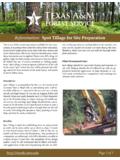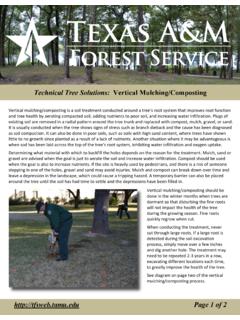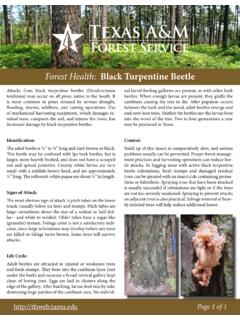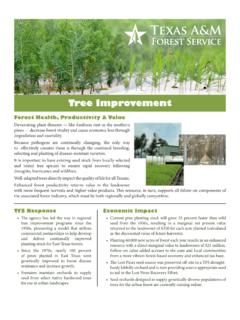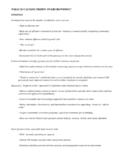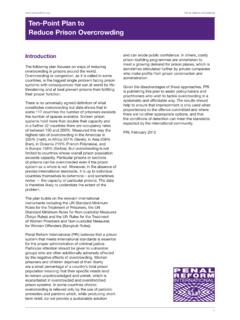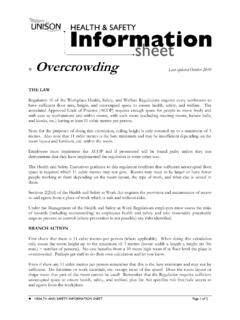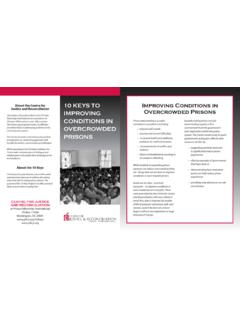Transcription of Timber Management: Intermediate Stand Management
1 Timber Management : Intermediate Stand Page 1 of 2If left unchecked, overcrowding conditions cause growth to slow leading to high risk of loss, and detrimental im-pact to economic investment. Stand density should be re-duced before stagnation occurs. Poor quality trees should be removed (through a practice called thinning) to real-locate site resources to the ultimate crop trees. While it would be nice to wait until trees had attractive economic value (merchantable) before a thinning was conducted, the biological requirements of the site may require that a pre-commercial thinning be conducted before trees reach merchantable size.
2 Pre-commercial thinning is costly, but when applied properly, is a financially sound decision. ISM harvests that thin out merchantable trees are called commercial thinnings and provide some immediate in-come to the landowner. The productivity of the site and prior Management activities affects the timing and inten-sity of thinning. However, commercial thinning generally takes place between years 12 and 15, with additional thin-ning at 5-8 year intervals thereafter. For more information on thinning, refer to Thinning Pine Stands at Quality:Not all trees are created equal.
3 It s easy to understand that tall, wide trees may be more valuable than short, skinny trees, for example, but value is also dependent upon other factors. Straightness of the main stem, number of knots within the first 17 feet of the tree and deformities resulting from disease, wind, or other environmental factors all im-pact the market value of the tree as well. Thinning opera-tions improve tree quality because they remove the sup-pressed, low-vigor and ill-formed trees within the Stand . As a result, Stand growth is focused on the higher vigor, straighter and disease free final crop trees.
4 But did you know that the dimensional lumber (2 x 10) Timber stands are a long-term crop, and as such, they require periodic and frequent cultivating treatments be-tween the time a Stand is established at around year 5 and the end of the rotation at around year 35. With Interme-diate Stand Management (ISM), Stand health, vigor and resiliency are improved. Several ISM options exist for the landowner. Application is influenced by site quality, Stand condition, and landowner objectives. No matter which is used, all ISM activities fo-cus on enhancing growth and vigor of desired trees.
5 Some activities result in immediate income; however, most ei-ther help grow income to be reaped in later harvests or serve as a natural deterrent to catastrophic loss. When Timber production is the main objective, then ISM focuses effort on redistributing resources on those trees that have the best potential to reach high-valued products beyond what would otherwise be produced. If wildlife manage-ment is the primary objective, then the composition of the Stand will be manipulated in a slightly different way in order to influence, for example, hard and soft mast pro-ducing trees.
6 Regardless, ISM achieves these objectives by: 1) manipulating Stand density, 2) improving tree form, stem quality and value, 3) managing the tree s nutritional requirements, 4) removing non-crop plants competing for nutrients, moisture, sunlight and space, 5) protecting the Stand from environmental Density: Stand density refers to the number and size of trees within a Stand . While it may be OK to have many small trees, it is not biologically sustainable to have many large ones. Often, pine stands simply have too many trees-per-acre competing for limited resources.
7 Even pine plantations, which were artificially regenerated by planting a set num-ber of trees per acre, often result in an overly-dense Stand . Timber Management : Intermediate Stand Page 2 of 2 Competition Control:All other, non-crop plants in the Stand compete with the crop trees for nutrients, moisture, sunlight and space. This battle has a negative and significant impact on growth of the ultimate crop trees. ISM treatments that reduce com-petition from other plants (especially hardwoods) can in-crease crop tree size as well as market value.
8 Competition control is especially important when fertilizer is applied so that only the crop tree receives the full benefit of the treatment. Prescribed fire is a treatment option available to landowners. Frequent, low-intensity prescribed burns reduce the number of non-crop trees and brush. It is ben-eficial to pine stands for a number of reasons including its provable improvement of wildlife habitat. In stands where burning is not applicable, landowners have the option to control competing vegetation with herbicide treatments. When applied correctly, modern herbicides are effective, safe, and persist in the environment for only a brief time.
9 In ISM, herbicides are most often broadcasted aerially, though in open stands they can be applied from the ground. Landowners can also effectively control un-desirable vines, shrubs, and trees through individual plant treatments. Herbicides may be applied as basal sprays, stem injections, and spot treatments to achieve the desired results. For more information on thinning, refer to Basal Spray for Woody Control at Protection:Trees are constantly at risk from numerous environment stressors such as storm events, drought, fire, insects, disease, and pollution.
10 The ability to resist these stressors is directly dependent upon tree health, vigor and Stand composition. Unmanaged stands tend to be unhealthy, low-vigor stands that lack the ability to resist damage, or recovery quickly from natural events. The best defense against most envi-ronmental stressors is a good offense; Manage stands for proper stocking levels of high-vigor, healthy trees. Stands should be managed appropriately from the start with care-ful consideration to genetics, stocking levels and nutrition. However, ISM also provides the necessary tending re-quired to reduce risk of loss from environmental stressors.

